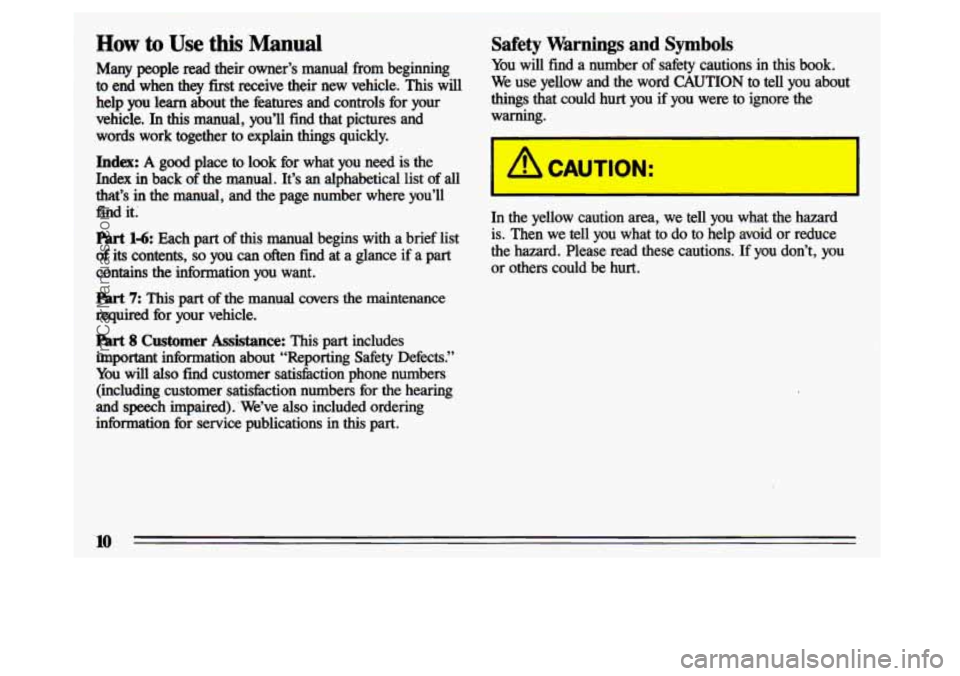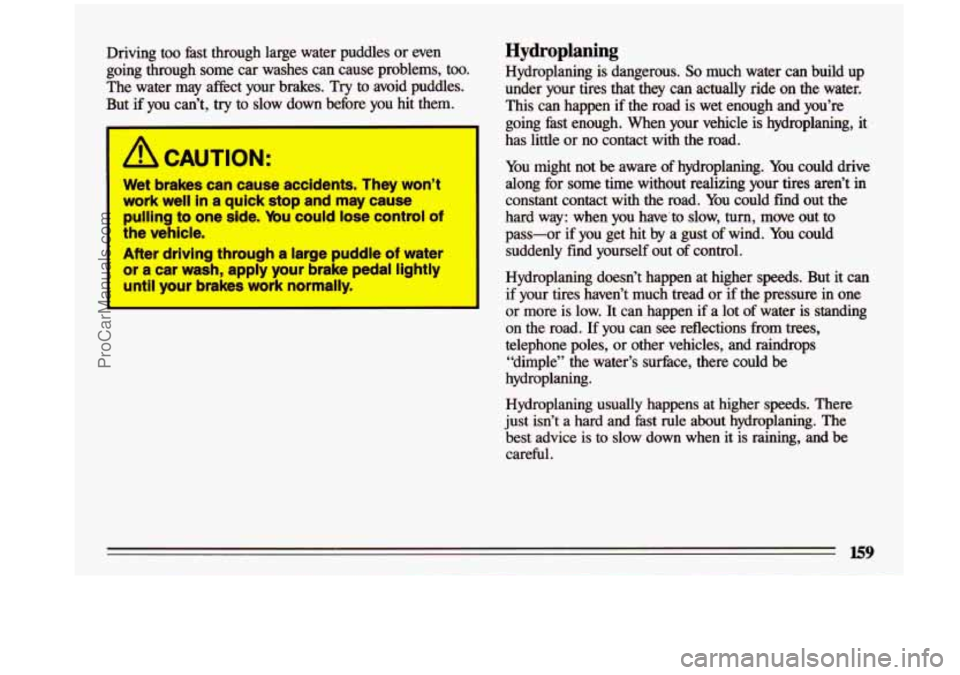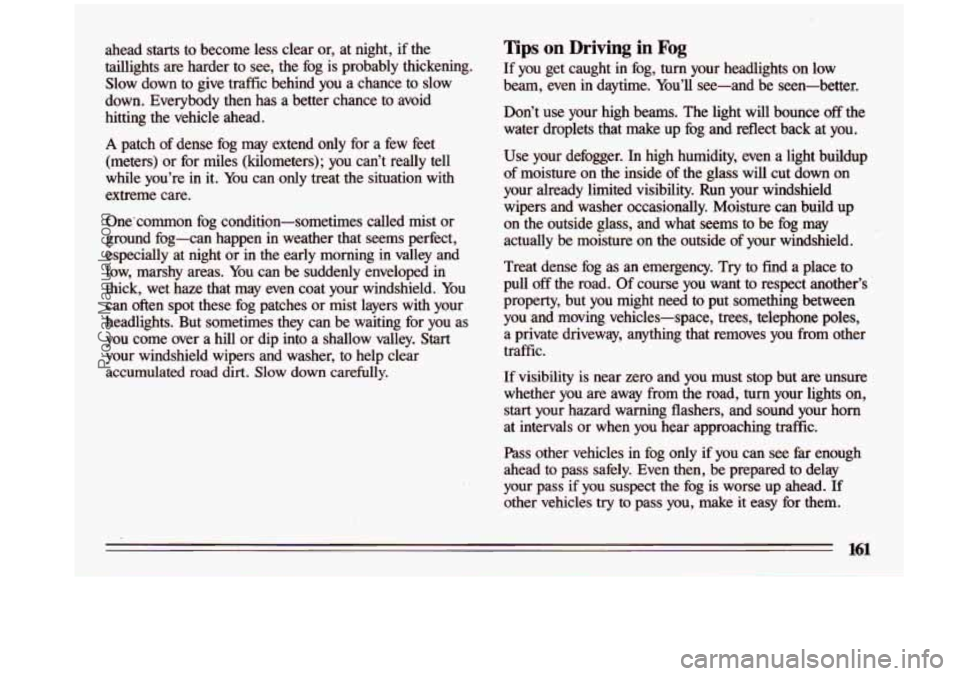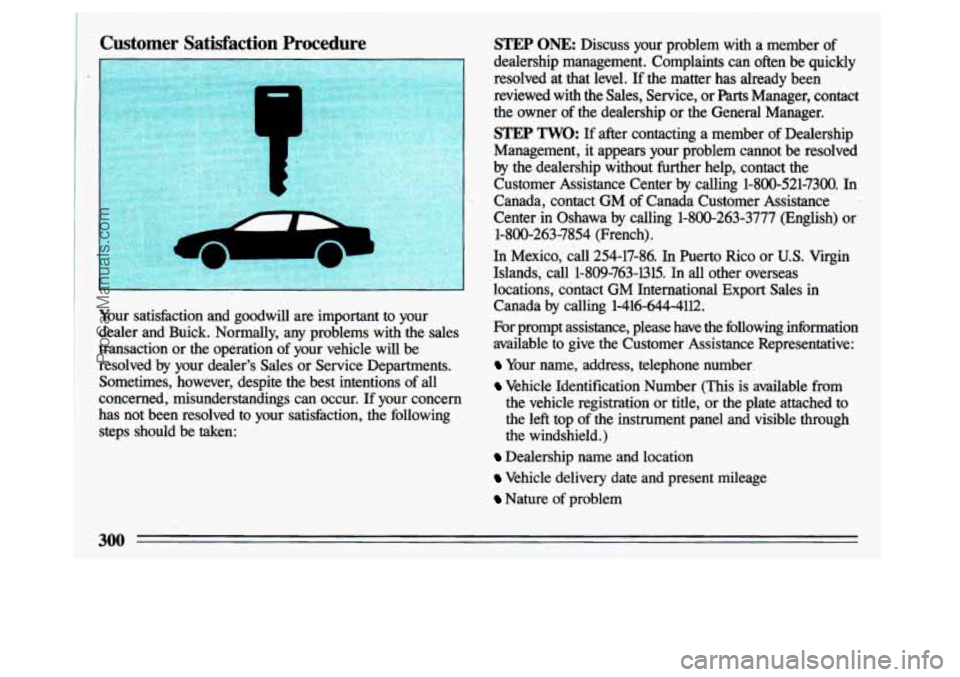1993 BUICK CENTURY phone
[x] Cancel search: phonePage 12 of 324

How to Use this Manual
Many people read their owner’s manual from beginning
to end when they first receive their new vehicle. This will
help you learn about the htures and controls for your
vehicle.
In this manual, you’ll find that pictures and
words work together
to explain things quickly.
Index: A good place to look fbr what you need is the
Index
in back of the manual. It’s an alphabetical list of all
that’s
in the manual, and the page number where you’ll
find it;
14: Each part of this manual begins with a brief list
of its contents, so you can often find at a glance if a part
contains the information you want.
part 7: This part of the manual covers the maintenance
required for your vehicle.
Part 8 Customer Assistance: This part includes
important information about “Reporting Safety Defects.”
You
will also find customer satisfaction phone numbers
(including customer satisfaction numbers for the hearing
and speech impaired). ‘We’ve also included ordering
information for service publications in
this part.
Safety Warnings and Symbols
You will find a number of safety cautions in this book.
We use yellow and the word CAUTION to tell you about
things that could hurt you
if you were to ignore the
warning.
I A CAUTION:
I
In the yellow caution area, we tell you what the hazard
is. Then we tell you what to do to help avoid or reduce
the hazard. Please read these cautions.
If you don’t, you
or others could be
hurt.
10
I
ProCarManuals.com
Page 161 of 324

Driving too fast through large water puddles or even
going through some car washes can cause problems, too.
The water may affect your brakes. Try to avoid puddles.
But if you can’t, try to slow down before you hit them.
A CAUTION:
Wet brakes can cause accidents. They-won’t
work well in
a quick stop and may cause
pulling to one side. Ybu could lose control
of
the vehicle.
After driving through a large puddle of water
or I car wash, apply your brake pedal lightly
until your
brakes work normally.
Hydroplaning
Hydroplaning is dangerous. So much water can build up
under your tires that they can actually ride on the water.
This can happen if the road is wet enough and you’re
going fast enough. When your vehicle
is hydroplaning, it
has
little or no contact with the road.
You might not be aware of hydroplaning. You could drive
along for some time without realizing your tires aren’t in
constant contact with the road. You could
find out the
hard way: when you have’to slow, turn, move out to
pass-or if you get hit
by a gust of wind. You could
suddenly find yourself out
of control.
Hydroplaning doesn’t happen at higher
speeds. But it can
if your tires haven’t much tread or
if the pressure in one
or
more is low. It can happen if a lot of water is standing
on the road.
If you can see reflections from trees,
telephone poles, or other vehicles, and raindrops
“dimple” the water’s surface, there could be
hydroplaning.
Hydroplaning usually happens at higher speeds. There
just isn’t a hard and
fast rule about hydroplaning. The
best advice is to slow down when it is raining, and be careful.
159
ProCarManuals.com
Page 163 of 324

ahead starts to become less clear or, at night, if the
taillights are harder to see, the fog is probably thickening.
Slow down to give traffic behind you a chance to slow
down. Everybody then has a better chance to avoid hitting the vehicle ahead.
A patch of dense fog may extend only for a few feet
(meters) or for miles (kilometers); you can’t really tell
while you’re in it. You can only treat the situation with
extreme care.
One‘common fog condition-sometimes called mist or
ground fog-can happen in weather that seems perfect,
especially at night or
in the early morning in valley and
low, marshy areas. You can be suddenly enveloped in
thick, wet haze that may even coat your windshield. You
can often spot these fog patches or mist layers with your
headlights. But sometimes they can be waiting for you as
you come over a hill or dip into a shallow valley.
Start
your windshield wipers and washer, to help clear
accumulated
road dirt. Slow down carefully.
Tips on Driving in Fog
If you get caught in fog, turn your headlights on low
beam, even in daytime. You’ll see-and be seen-better.
Don’t use your high beams. The light will bounce
off the
water droplets that make up fog and reflect back at you.
Use your defogger. In high humidity, even a light buildup
of moisture on the inside of the glass will cut down on
your already limited visibility. Run your windshield
wipers and washer occasionally. Moisture can build up
on the outside glass, and what seems to be fog .may
actually be moisture on the outside
of your windshield.
Treat dense fog as an emergency.
Try to find a place to
pull off the road. Of course you want to respect another’s
property, but you might need to put something between
you and moving vehicles-space, trees, telephone poles,
a private driveway, anything that removes you from other
traffic.
If visibility is near zero and you must stop but
are unsure
whether you are away from the road, turn your lights on,
start your hazard warning flashers, and sound your horn
at intervals or when you hear approaching traffic.
Pass other vehicles in fog only if you can see far enough
ahead to pass safely. Even then, be prepared
to delay
your pass if you suspect the fog is worse up ahead.
If
other vehicles try to pass you, make it easy for them.
161
ProCarManuals.com
Page 302 of 324

lustomer Satisfaction Procedure
Your satisfaction and goodwill are important to your
dealer and Buick. Normally, any problems with the sales
transaction or the operation of your vehicle will be
resolved by your dealer’s Sales or Service Departments.
Sometimes, however, despite the best intentions of all
concerned, misunderstandings can occur. If your concern
has not been resolved to your satisfaction,
the following
steps should be taken:
STEP ONE: Discuss your problem with a member of
dealership management. Complaints can often be quickly
resolved at that level. If the matter has already been
reviewed with the Sales, Service, or
Parts Manager, contact
the owner of the dealership or the General Manager.
STEP TWO: If after contacting a member of Dealership
Management; it appears your problem cannot be resolved
by the dealership without further help, contact the
Customer Assistance Center by calling 1-800-521-7300. In
Canada, contact GM of Canada Customer Assistance
I
Center in Oshawa by calling 1-800-263-3777 (English) or
1-800-263-7854 (French).
In Mexico, call 254-17-86. In herto
Rico or U.S. Virgin
Islands, call 1-809-763-1315. In all. other overseas
locations, contact
GM International Export Sales in
Canada by calling 1-416-644-4112.
For prompt assistance, please have the following information
available to give the Customer Assistance Representative:
Your name, address, telephone number.
Vehicle Identification Number (This is available from
the vehicle registration or title, or the plate attached to
the left top of the instrument panel and visible through
the windshield.)
Dealership name and location
Vehicle delivery date and present mileage
Nature of problem
300
ProCarManuals.com
Page 306 of 324

Individual PSP’s
If you don’t want to buy all the PSP’s issued by Buick for
all models in the model year, you can buy individual
PSPs, such as those which may pertain to a particular
model. To do this,
you will first need to see our index of
PSP’s. It provides a variety of information. Here’s what
.
you’ll find in the index and how you can get one:
What You’ll Find in the Index
A list of all PSP’s published by Buick in a model year
(1989 or later). PSP’s covering all models of Buick cars
are listed in the same index.
Ordering information so you can buy the specific PSP’s
you may want.
Price information for the PSPs you may want to buy.
How You Can Get an Index
Indexes are published periodically. Most of the PSP’s
which could potentially apply to the most recent Buick
models will be listed in the most recent publication for
that model year. This means you may want to wait until
the end of the model year before ordering
an index, if
you are interested in buying PSP’s pertaining to a current
model year car or truck. model year that is not over yet, we’ll send you the
most
recently published issue. Check the ordering form for
indexes for earlier model years.
Cut out the ordering form, fill it out, and mail it in. We
will then see to
it that an index is mailed to you. There is
no charge for indexes for the 1989-1993 model years.
Toll-Free Telephone Number
If you want an additional ordering form for an index or a
subscription, just call toll-free and we’ll be happy
to send
you one. Automated recording equipment will take your
name and mailing address. The number to call is
Copies
at participating Dealers
Copies of indexes and individual PSP’s are at your
participating Buick dealer. You can ask to see them.
A
VERY IMPORTANT REMINDER
These PSP’s are meant for technicians. They are not
meant for the “do-it-yourselferl’ Technicians have the
equipment, tools, safety instructions, and know-how to
do a job quickly and safely.
1-800-551-4123.
Buick Service Publications
You can get these
by using the order form:
Some PSPs pertaining to a particular model year vehicle
may be published in later years, and these would
be listed
in the later year’s index. When you order
an index for a
304
ProCarManuals.com